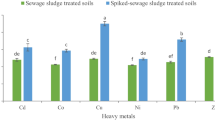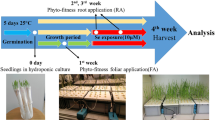Abstract
Purpose
Environmental chemistry of antimony (Sb) is still largely unknown. Many questions remain about its availability to plants and effects of fertilizers on mobility of Sb in the rhizosphere soil. In this work, we focused on the following problems: (1) uptake of Sb by wheat seedlings grown in soil enriched with this metalloid and (2) impact of soil amendments on the plant growth, Sb uptake from soil, and its transfer from roots to upper plant parts.
Materials and methods
To obtain further information on the possible transfer of Sb into plants, greenhouse pot experiments were carried out. Soil was spiked with 15 mg kg−1 of Sb and amended with either chicken manure or natural growth stimulator Energen. Wheat Triticum aestivum L. seedlings were grown in the soil during 17 days. Plants together with rhizosphere soil were collected several times in the course of the experiment. The ICP-OES and ICP-MS techniques were applied to determine the concentrations of macro- and trace elements in the plant and soil material.
Results and discussion
Growth of wheat seedlings in Sb-spiked soil resulted in Sb accumulation in roots and leaves of the plants. Energen and especially chicken manure were capable of stimulating transfer of Sb to more mobile and, as a consequence, more available to the plants form, thus enhancing both uptake of Sb from soil and its transfer from roots to upper plant parts. The accumulation of Sb by plants led to a decrease of Sb concentration in the rhizosphere soil with time, and the most significant decrease was observed after amendment of soil with fertilizers.
Conclusions
Fertilizers may be used to increase phytoextraction of Sb and its removal from contaminated soils. However, such an amendment of soil should be done with caution in order to exclude or at least reduce the negative effects on plants.





Similar content being viewed by others
References
Baylis R (2012) Antimony market to remain volatile while China restructures for the future. http://www.roskill.com/reports/minor-and-light-metals/antimony. Accessed 10 Sept 2012
Bolan NS, Duraisamy VP (2003) Role of inorganic and organic soil amendments on immobilization and phytoavailability of heavy metals: a review involving specific case studies. Austr J Soil Res 41:533–555
Conesa HM, Wieser M, Gasser M, Hockmann K, Evangelou MWH, Studer B, Schulin R (2010) Effects of three amendments on extractability and fractionation of Pb, Cu, Ni, and Sb in two shooting range soils. J Hazard Mater 181:845–850
Conesa HM, Wieser M, Studer B, González-Alcaraz MN, Schulin R (2012) A critical assessment of soil amendments (slaked lime/acidic fertilizer) for the phytomanagement of moderately contaminated shooting range soils. J Soils Sediments 12:565–575
Cooper RG, Harrison AP (2009) The exposure to and health effects of antimony. Indian J Occup Environ Med 13:3–10
Fageria NK, Baligar VC, Jones CA (2011) Growth and mineral nutrition of field crops. CRC Press, Boca Raton, FL, USA
Feng R, Wei C, Tu S, Wu F, Yang L (2009) Antimony accumulation and antioxidative responses in four fern plants. Plant Soil 317:93–101
Filella M, Williams PA, Belzile N (2009) Antimony in the environment: knowns and unknowns. Environ Chem 6:95–105
He M (2007) Distribution and phytoavailability of antimony at an antimony mining and smelting area, Hunan, China. Environ Geoch Health 29:209–219
He M, Yang J (1999) Effects of different forms of antimony on rice during the period of germination and growth and antimony concentration in rice tissue. Sci Tot Environ 243–244:149–155
Jia N, Sun L, He X, You K, Zhou X, Long N (2012) Distributions and impact factors of antimony in topsoils and moss in Ny-Ålesund, Arctic. Environ Pollut 171:72–77
Kelly DG, Mattson KM, Nielsen KS, Weir RD, White SD (2012) Neutron activation analysis of antimony in soils: a comparison of NAA with digestion/ICP-MS methods and “consensus” laboratory data. J Radioanal Nucl Chem 291:89–94
Kilgour DW, Moseley RB, Barnett MO, Savage KS, Jardine PM (2007) Potential negative consequences of adding phosphorus-based fertilizers to immobilize lead in soil. J Environ Qual 37:1733–1740
Kronzucker HJ, Coskun D, Schulze LM, Wong JR, Britto DT (2013) Sodium as nutrient and toxicant. Plant Soil 369(1–2):1–23
Malhi SS, Johnston AM, Schoenau JJ, Wang ZL, Vera CL (2006) Seasonal biomass accumulation and nutrient uptake of wheat, barley, and oat on a Black Chernozem Soil in Saskatchewan. Can J Plant Sci 86:1005–1014
Murciego AM, Sánchez AG, González MA, Gil EP, Gordillo CT, Fernández JC, Triguero TB (2007) Antimony distribution and mobility in topsoils and plants (Cytisus striatus, Cistus ladanifer, and Dittrichia viscosa) from polluted Sb-mining areas in Extremadura (Spain). Environ Pollut 145:15–21
Oorts K, Smolders E, Degryse F, Buekers J, Gasco G, Cornelis G, Mertens J (2008) Solubility and toxicity of antimony trioxide (Sb2O3) in soil. Environ Sci Technol 42:4378–4383
Pan X, Zhang D, Chen X, Bao A, Li L (2011) Antimony accumulation, growth performance, antioxidant defense system, and photosynthesis of Zea mays in response to antimony pollution in soil. Water Air Soil Pollut 215:517–523
Qi C, Wu F, Deng Q, Liu G, Mo C, Liu B, Zhu J (2011) Distribution and accumulation of antimony in plants in the super-large Sb deposit areas, China. Microchem J 97:44–51
Salminen R (2005) Geochemical atlas of Europe. Part 1: background information, methodology, and maps. Geological Survey of Finland, Espoo
Shtangeeva I, Laiho J, Kahelin H, Surin V (2008) Effects of ISPOLIN fertilizer on uptake of macro- and trace elements by wheat Triticum aestivum grown in two different soils. J Plant Nutr 31:395–407
Shtangeeva I, Bali R, Harris A (2011) Bioavailability and toxicity of antimony. J Geochem Explor 110:40–45
Shtangeeva I, Steinnes E, Lierhagen S (2012) Uptake of different forms of antimony by wheat and rye seedlings. Environ Sci Pollut Res 19:502–509
Smichowski P (2007) Antimony in the environment as a global pollutant: a review on analytical methodologies for its determination in atmospheric aerosols. Talanta 75:2–14
Tschan M, Robinson B, Johnson CA, Bürgi A, Schulin R (2010) Antimony uptake and toxicity in sunflower and maize growing in SbIII and SbV contaminated soil. Plant Soil 334:235–245
USEPA Method 3052 (1996) Microwave assisted acid digestion of siliceous and organically based matrices. http://www.caslab.com/EPA-Methods/PDF/EPA-Method-3052.pdf
Wan X-M, Tandy S, Hockmann K, Schulin R (2013) Changes in Sb speciation with waterlogging of shooting range soils and impacts on plant uptake. Environ Pollut 172:53–60
Wenzel WW (2009) Rhizosphere processes and management in plant-assisted bioremediation (phytoremediation) of soils. Plant Soil 321:385–408
Willems JH, Nieuwstadt MGL (1996) Long-term after effects of fertilization on aboveground phytomass and species diversity in calcareous grassland. J Vegetat Sci 7:177–184
Wilson SC, Lockwood PV, Ashley PM, Tighe M (2010) The chemistry and behavior of antimony in the soil environment with comparisons to arsenic: a critical review. Environ Pollut 158:1169–1181
Wilson SC, Leech CD, Butler D, Lisle L, Ashley PM, Lockwood PV (2013) Effects of nutrient and lime additions in mine site rehabilitation strategies on the accumulation of antimony and arsenic by native Australian plants. J Hazard Mater. doi:10.1016/j.jhazmat.2013
Yruela I (2005) Copper in plants. Braz J Plant Physiol 17:145–156
Acknowledgments
Irina Shtangeeva acknowledges financial support from the Academy of Finland. The authors are grateful to Seija Liikanen and Päivi Vesala (University of Oulu, Department of Chemistry) for helping with the sample analysis.
Author information
Authors and Affiliations
Corresponding author
Additional information
Responsible editor: Jaume Bech
Rights and permissions
About this article
Cite this article
Shtangeeva, I., Niemelä, M. & Perämäki, P. Effects of soil amendments on antimony uptake by wheat. J Soils Sediments 14, 679–686 (2014). https://doi.org/10.1007/s11368-013-0761-8
Received:
Accepted:
Published:
Issue Date:
DOI: https://doi.org/10.1007/s11368-013-0761-8




